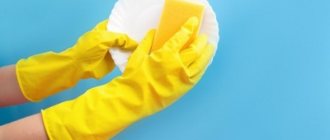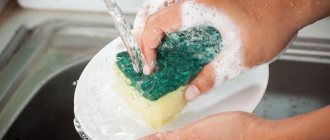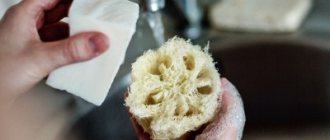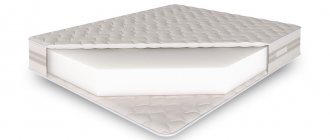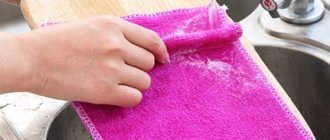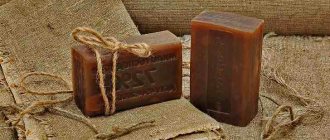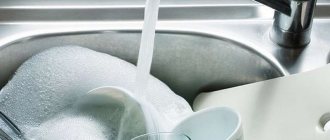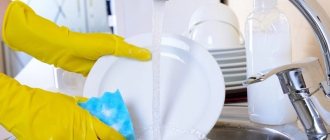Few people have ever wondered why household sponges come in different colors. Perhaps this information will be a real discovery for someone.
It turns out that color is an indicator of the hardness of the sponge. And to be more precise, it is an indicator of the hardness of a special coating on household sponges, the so-called abrasive (glued on top of foam rubber).
Sponge manufacturers have developed a color designation that allows you to select the hardness of the product that is most suitable for removing dirt and delicateness.
Green and black colors are used to indicate maximum rigidity of the material. Red and blue – medium hardness of the material.
Yellow and white are soft and delicate materials. You can safely use it to wash surfaces and not be afraid of scratches.
Different colors are ideal for marking sponges so as not to confuse them.
For example, green ones are for the sink, white ones are for glasses.
There are many types of household sponges that are designed to clean a particular surface.
How are dish sponges made?
To create such assistants for housewives, first a roll of fiber is taken, which is fixed on a special machine and tucked into unwinders. To understand what a dishwashing sponge is made of and consists of, you should imagine hot melt adhesive. It is applied to the prepared fiber, elastic polyurethane foam is attached here, after which the future workpiece is cut off and sent to a pneumatic press. All this ends with polymerization. Here's how and what dishwashing sponges are made of.
Production
Sponges are produced industrially, using special machines and additional equipment. The quality of the sponge depends on compliance with the entire technological process, compliance with glue standards and the equipment itself.
The standard line includes several machines:
- Mixer for preparing the composition.
- Belt conveyor or block molds.
- Band machine (horizontal or vertical).
- Equipment for dosing components, etc.
You can watch the making of sponges in the video:
Classification by material
Foam rubber experts of cleanliness are most often found in the kitchen of housewives. The material is porous, so it is enough to apply even a drop of detergent here and a sufficient amount of foam will form.
But what an abrasive sponge is made of is foam rubber, on the surface of which there is an abrasive coating. It looks like fine sandpaper. This layer will help cope not only with dirt on dishes, but also on the hob, on the sink, on household appliances, and on the bathtub. That's what an abrasive kitchen sponge is.
A microfiber washcloth is environmentally friendly; it gently washes dirty surfaces, but is not durable.
And the silicone sponge has a long service life; it can be used to clean even delicate objects. It does not absorb dirt and grease and is antibacterial.
Viscose is used for the production and manufacture of cellulose household sponges for washing dishes. It is environmentally friendly, hypoallergenic.
A plastic sponge can be used on a variety of surfaces, including those that need to be carefully cleaned.
The material chosen depends on where the sponges are used. Metal ones are made of thin wire. They are intended for washing complex stains and burnt food from durable surfaces. But this material is not intended to work with dishes made of enamel, ceramics, or Teflon, since the sponge is made from metal raw materials that scratch some surfaces.
From cut pile loop
The newest Korean development. It seems that the Koreans cast some kind of spell over these sponges. There is simply no other way to explain the desire to wash everything for her, without household chemicals. Let us explain that it’s all about the special structure of the fabric - a cut pile loop. It helps to effectively clean all types of contaminants.
+
- does not require detergents, the savings are obvious
- restores its properties after washing in a washing machine
- has unique cleaning properties
–
- requires careful care and timely washing
Tip: similar rags can be used to wash dishes, as well as absolutely any kitchen surfaces. When choosing, pay attention to the information on the packaging and use the right side for each type of work.
Sizes, shapes
It is more advisable to buy a kitchen aid that fits in your hand. But for hard-to-reach places, it is sometimes more convenient to use small washcloths. Speaking about what other sizes of dishwashing sponges there are, it is worth noting that these are large. They can quickly wash even large surfaces. But the cleanliness attribute must be easy to use. In addition to the usual rectangular shape, a dish sponge can have the following shape:
- oval,
- square,
- curly,
- profile,
- with grip.
Research results
According to a National Science Foundation study (2011), the dirtiest places in the kitchen are table napkins and dish sponges. Three out of four sponges and wipes were found to be contaminated with E. coli and salmonella.
Scientists from the University of Giessen. Yu. Liebig examined sponges, the period of use of which ranged from 7 days to a month, and found 360 types of microbes in them, five of which were very dangerous.
According to another study, the number of bacteria on a week-old sponge can exceed the Earth's population by tens of times.
How to determine quality
When deciding which sponges are best for washing dishes, you need to focus on:
- on the reliability of the manufacturer;
- efficiency and ease of use of the product;
- then whether small particles of abrasive material remain in the hand;
- no unpleasant odor;
- what surfaces the product is intended for cleaning.
Also, a sponge for washing dishes must comply with GOST, and if people who are prone to allergies buy it, then it is important to choose a product that does not lead to such reactions.
Microbiological aspect[edit | edit code]
Sponges are difficult to clean and can transmit infection[8].
Sponges containing a cellulose component provide a suitable growth medium for a variety of microbial species, especially if kept wet between uses[9]. Due to the complexity and ineffectiveness of the disinfection process and the danger of some methods, periodic replacement of sponges is recommended, especially if they produce unpleasant odors[10][11][12]. It is recommended to replace the sponges weekly or two weeks after use[13][14].
How to store and use
The foam sponge needs to be renewed at least once a week. And if the washcloth is made of natural material, then once every 1 or 2 months.
Here's how to store a sponge for washing dishes; for this, use a soap dish, a specially purchased open container. Sometimes they place a wrung-out washcloth on the edge of the sink.
If you want to store a sponge for washing dishes in the kitchen so that it is not visible, then this item is dried to a slightly damp state and, after use, is put away in the cabinet under the sink.
Tips for use
To protect yourself and your household from bacteria and the infectious diseases they cause, you should listen to simple but very effective advice:
Wash dishes immediately after eating to reduce the risk of bacteria growing and growing.- For foam sponges, use each side depending on how dirty the dishes are.
Which side should I wash? If these are plates for which you will only need detergent and hot water, then use the soft side.Pans, pots, and burnt dishes should be cleaned with the hard side.
- After using detergents, be sure to rinse the dishes with hot water and then wipe dry with a towel.
- Do not forget to regularly clean the sink and the sink around it, but it is advisable to have a separate sponge for this.
- At the end of the day, for disinfection purposes, you can hold the sponge in a saline solution for 15-20 minutes, then rinse thoroughly with hot water.
- After the end of their service life, eco-activists recommend burning or burying sponges made from natural materials in the ground (thanks to their rapid decomposition, they will even bring some benefit to the soil).
How to make a laundry sponge yourself instead of using a store-bought sponge to wash dirty dishes
To make such a kitchen accessory, you can use a vegetable net, jute or tulle. Thick, dense, unpainted foam rubber is also suitable. This kitchen accessory of the desired shape is cut out of it.
Here's how else you can replace a sponge for washing dishes: if you bought an onion in a net, then you need to fold it 4 times and tie it with a crochet hook. It will also be useful for creating a jute washbasin.
Notes[edit | edit code]
- ↑ Ozhegov S.I., Shvedova N.Yu.
Uklyuchina // Explanatory dictionary of the Russian language / Russian Academy of Sciences. Institute of Russian Language named after V.V. Vinogradov. — 4th ed., add. - M.: Azbukovnik, 1997. - ↑ Efremova T. F.
Gubka // Modern explanatory dictionary of the Russian language: In 3 volumes. - M.: AST, Astrel, Harvest, 2006. - ISBN 5-17-029521-9, ISBN 5-17-013734-6, ISBN 5-271-12339-1, ISBN 5-271-12338-3, ISBN 985-13-4715-9. - ↑ Yu. Dobrynya.
Sponges in our house // Biology for every educated person. - AST, 2022. - P. 131. - ↑ Species // Sponges: world production and markets (English). fao.org
. Food and Agriculture Organization of the United Nations (October 1990). Access date: July 24, 2022. - ↑ Sea sponges (undefined)
. Date accessed: November 27, 2022. - ↑ Global Sponge Market 2022 (unspecified)
. Date accessed: November 27, 2022. - ↑ N.S.
Alekseev. Merchandising of household goods. - Economics, 1977. - T. I. - P. 177, 211. - ↑ SanPiN 1163-74 Sanitary rules for the design and maintenance of beauty parlors in public utility and consumer services institutions.
- ↑ Reducing bacteria in household sponges – ProQuest (English). search.proquest.com
18-22. Denver: Journal of Environmental Health; Vol. 62, Iss. 1 (Jul/Aug 1999). Access date: July 24, 2022. - ↑ Klein, Joanna
We Need to Talk Some More About Your Dirty Sponges.
The New York Times
(11 August 2017). Access date: July 24, 2022. - ↑ Klein, Joanna
Cleaning a Dirty Sponge Only Helps Its Worst Bacteria, Study Says.
The New York Times
(4 August 2017). Access date: July 24, 2022. - ↑ Microbiological Safety of Kitchen Sponges Used in Food Establishments
- ↑ How often to replace sponges, which have more bacteria than toilets - Business Insider
- ↑ When Should You Throw Out Your Sponge? | MyRecipes
- ↑ International trade // Sponges: world production and markets (English). fao.org
. Food and Agriculture Organization of the United Nations (October 1990). Access date: July 24, 2022.
Poron sponge with grip
These sponges are usually sold in a set of two. One of the sponges is for removing dirt from Teflon and delicate surfaces, the other is for rough cleaning of dirt, carbon deposits and other things. Advantages: comfortable to hold, no chance of injuring your hands during intensive cleaning. More durable than standard foam sponges. Disadvantages: the sponge is made of foam rubber and requires periodic change, they are more expensive than usual, and due to their unpopularity they are rarely found in stores.
Rules of care
Kitchen sponges require high-quality care. Otherwise, they can become a breeding ground for pathogens, lose their appearance and functionality, and acquire an unpleasant odor.
Preventive care measures include:
- Keeping washcloths clean. It needs to be washed after use.
- Store with good ventilation, allowing excess water to drain off.
- When the sponge wears out, it must be replaced with a new one. It is also necessary to remember the expiration date of washcloths. Silicone ones last the longest; they are replaced after a few months of use.
The best melamine sponges for shoes and clothes
Such sponges can be used not only for caring for clothes and shoes, but this is precisely the task they cope with best. We looked at 5 options with the most striking characteristics and chose from them one of the best melamine sponges based on customer reviews.
Ginger cat
The “Red Cat” melamine sponge is designed for the gentle removal of all types of dirt from various surfaces – wood, metal, fabric, glass, ceramic. According to the principle of use, it is similar to a stationery grater and when removing traces of grease, dust, rust, wool, it wears out in the same way, but this process can be slowed down by positioning the product at an angle during processing. The washcloth has almost no smell and is suitable for allergy sufferers. Its lack of a top layer makes it easy to clean hard-to-reach places.
Advantages
- Low price;
- Sold in 2 pieces. packaged;
- Rectangular shape;
- Lasts a long time;
- Does not contain additional components;
- Fast results.
Flaws
- Not detected.
